


|
|
|
The setting was ideal. The sky was a palette of purple and orange as the sun set over the Sahayadri range and a cool breeze rustled through the sugarcane fields. With a cry of "Shree Guru Dev Dutta Bola Pundalik Varde Hari Vitthal Shree Gyandev Tukaram�, six rather lean men in striped, Dada Kondke shorts and vests lift and hoist the kaahil, a 300 kilo steel vessel containing piping hot waafaa, the liquid gur or jaggery, and pour it into a 9 1/2 by 9 1/2 foot cemented square pit in the ground. This procedure is repeated fivetimes a day from 4 p.m. into the early hours of the morning from November to February at gurhals across Maharashtra. The villages around Kolhapur are dotted with numerous gurhals � the place where sugarcane is turned into jaggery and the sight of brick smoking chimneys amid the tall sugarcane crop is not uncommon.
What strikes you about the entire process is the simplicity of it all. The only machine in sight is a small electrically-run sugarcane crusher and even that has two men diligently pushing sugarcane into it. Yet gurhals serve their purpose, producing gur with the utmost of efficiency. Each two-hour gur-making session producing two quintals of gur, that�s 10 quintals a day. The sarpanch of Nigve Village, Suresh Patil, owned the gurhal we visited. Like most gurhal owners he has his own farm but also buys sugarcane from elsewhere once his fields are harvested. On Patil�s farm 11 men are employed to break the cane. And 12 more work at the gurhal earning Rs. 65 and two kilos of gur a day.
The juice is repeatedly stirred using a rahat, a rotating cylindrical wheel used to churn the liquid until it boils, changing consistency along the way. Some of it is then removed, to be bottled and sold as kakvi. Similar to honey, kakvi has medicinal properties and is said to work wonders on jaundice patients. It is often eaten with chapatti and a little ghee for added taste. Through the process more men in stripped shorts make an appearance from time to time to check that the gur is the right colour. Fair is lovely in this trade as well, with the lighter coloured gur fetching a higher price at auctions or soudas in Kolhapur�s Shahupuri Market yard. The price is decided upon by the quality and demand for jaggery, normally fetching between Rs.1,200 to Rs.1,500 per quintal. The darker gur, which uses juice from the bhendi tree to purify it, is sold for less at auctions although many prefer its taste.
Once it�s the right consistency, the six men spring into action. A pulley is attached to the kaahil and they�re off. The juice is poured into the square and stirred rapidly with big wooden spades. It takes about 15 minutes for it to form a sticky consistency similar to gooey toffee. We tried it warm and sticky on a sugarcane stick. A delicious but messy experience. The jaggery is then filled into cloth-lined moulds of 1, 2, 10 and 30 kilos using a haal or large flat spoon and carted off to the market to be sold.
Meanwhile, on the Kolhapur-Bombay Highway, small stalls run by enterprising farmers sell fresh and cold sugarcane juice. These farmers keep a small percentage of their crop for this purpose. The sugarcane is crushed as soon as a customer drives up. It is spiked with ginger and lime, some crushed ice, and costs less than ten rupees a glass. Next time you are driving past stop and have some. Empty the beer bottle and fill it with fresh sugarcane juice. You will not regret the decision.
|

Home Page
About the mag
Subscribe
Advertise
Contact Us

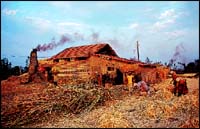 Jaggery Kolhapur�s Molten Gold
Jaggery Kolhapur�s Molten Gold
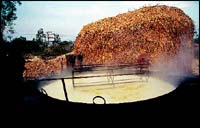 Kolhapur is an agriculturally rich area and the fact that it has one of the highest per capita incomes in the country has a lot to do with the fields around it. There are approximately 600-700 gurhals in the area and this is a Rs. 760 million turnover industry. The former Kolhapur Maharaja, Shahu Maharaj, was a forward-thinking man and a lot can be credited to him. He made provisions for irrigation 150 years ago and the rest is a farmer�s dream.
Kolhapur is an agriculturally rich area and the fact that it has one of the highest per capita incomes in the country has a lot to do with the fields around it. There are approximately 600-700 gurhals in the area and this is a Rs. 760 million turnover industry. The former Kolhapur Maharaja, Shahu Maharaj, was a forward-thinking man and a lot can be credited to him. He made provisions for irrigation 150 years ago and the rest is a farmer�s dream.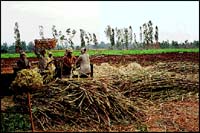 Once the crop is broken it is passed though a crusher to remove the juice. The refreshing and cooling ganna ras is a saccharine sweet drink that tastes good when drunk with a dash of ginger and lime. Nothing is wasted in the process including the dried sugarcane waste or bagasse, which is burnt and used as fuel in the chulwan or furnace, over which the juice is heated.
Once the crop is broken it is passed though a crusher to remove the juice. The refreshing and cooling ganna ras is a saccharine sweet drink that tastes good when drunk with a dash of ginger and lime. Nothing is wasted in the process including the dried sugarcane waste or bagasse, which is burnt and used as fuel in the chulwan or furnace, over which the juice is heated.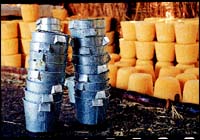 In the final stages of gur-making a white moustached man with a furrowed face � the gur master-taster or gulvya �makes an entrance. His job is to check the final consistency of the gur. The gulvya in Patil�s gurhal has been doing his job for 35 years, learning the tricks of the trade from gulvyas before him. He proceeds to dip his hands in cold water and lets a drop of the boiling gur fall on his palm. He then tries to roll it into a ball, if it forms, the gur is ready, if not it is left to boil some more.
In the final stages of gur-making a white moustached man with a furrowed face � the gur master-taster or gulvya �makes an entrance. His job is to check the final consistency of the gur. The gulvya in Patil�s gurhal has been doing his job for 35 years, learning the tricks of the trade from gulvyas before him. He proceeds to dip his hands in cold water and lets a drop of the boiling gur fall on his palm. He then tries to roll it into a ball, if it forms, the gur is ready, if not it is left to boil some more.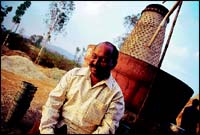 The entire process works like a well-oiled machine. It hasn�t changed much over the years but to the people working in the gurhals there is little reason for it to � gurhals produce 60,000 million tonnes of gur a year. They will continue to produce gur from sugarcane through the time-tested method the way generations before them have. Oblivious of the overpowering smell of sugarcane juice being cooked and the sun setting splendidly behind them over the distant mountains.
The entire process works like a well-oiled machine. It hasn�t changed much over the years but to the people working in the gurhals there is little reason for it to � gurhals produce 60,000 million tonnes of gur a year. They will continue to produce gur from sugarcane through the time-tested method the way generations before them have. Oblivious of the overpowering smell of sugarcane juice being cooked and the sun setting splendidly behind them over the distant mountains.